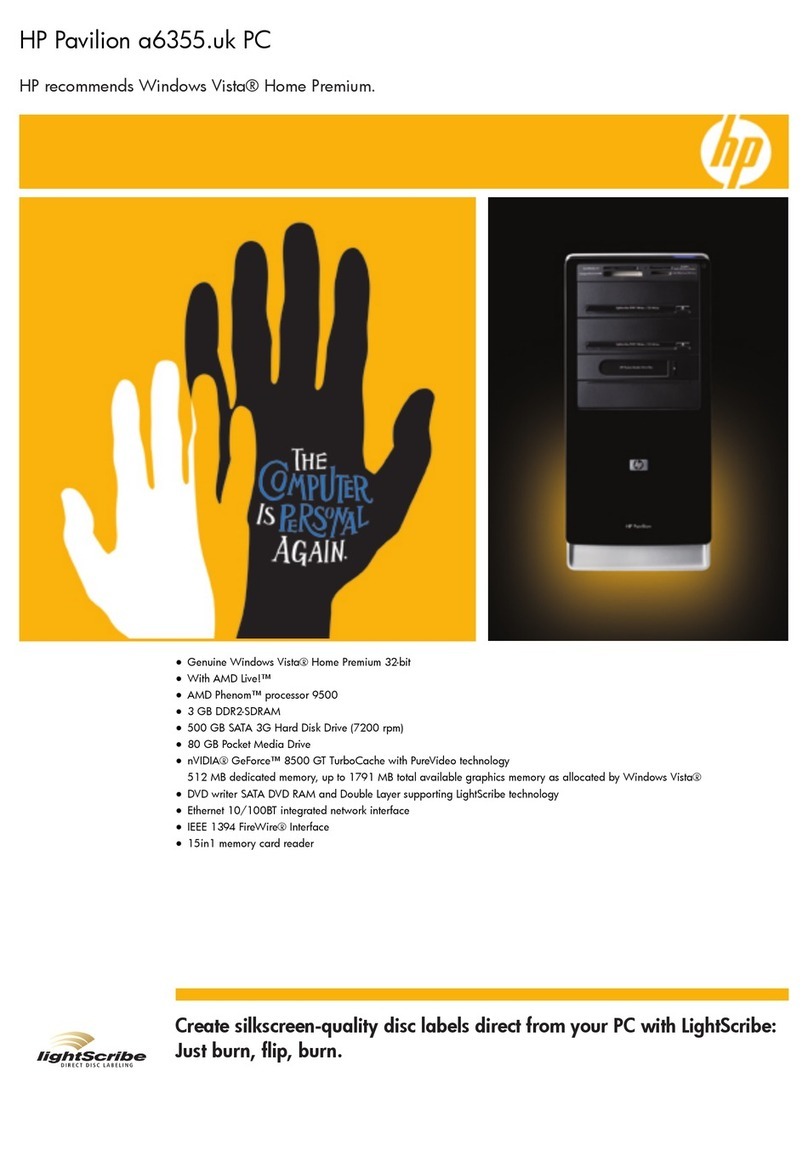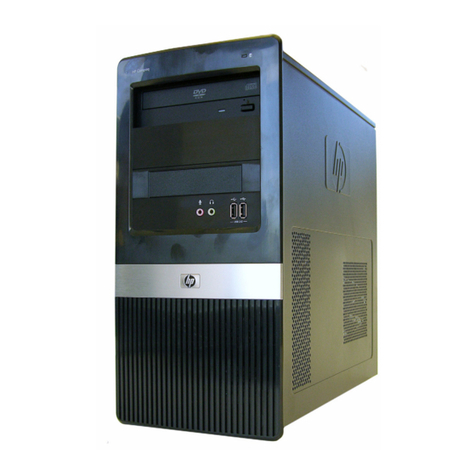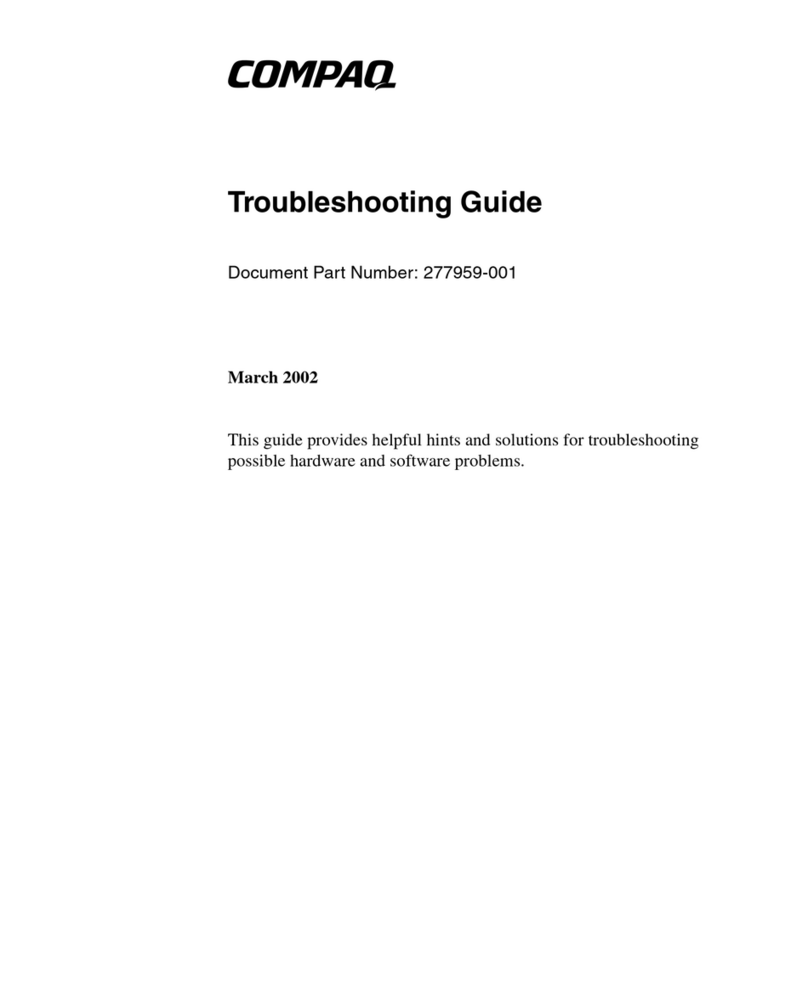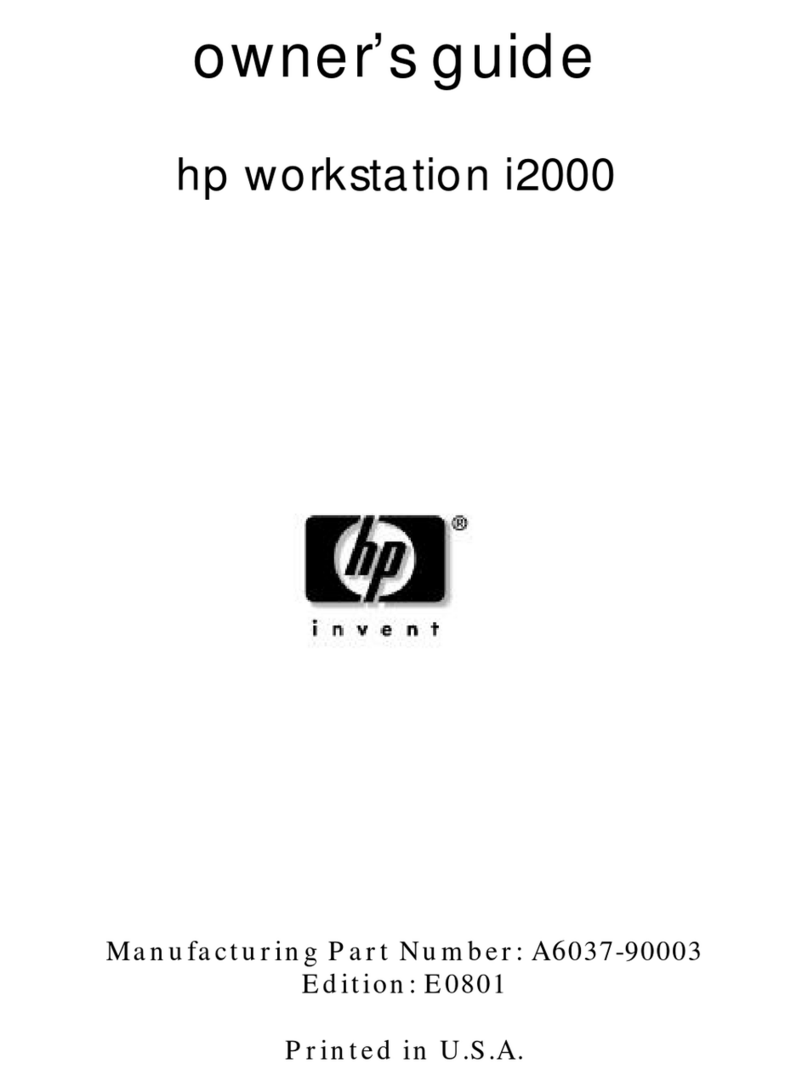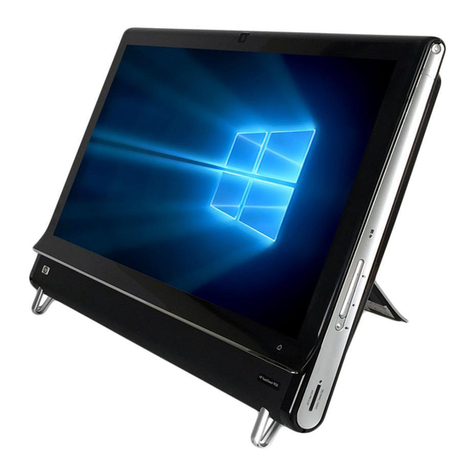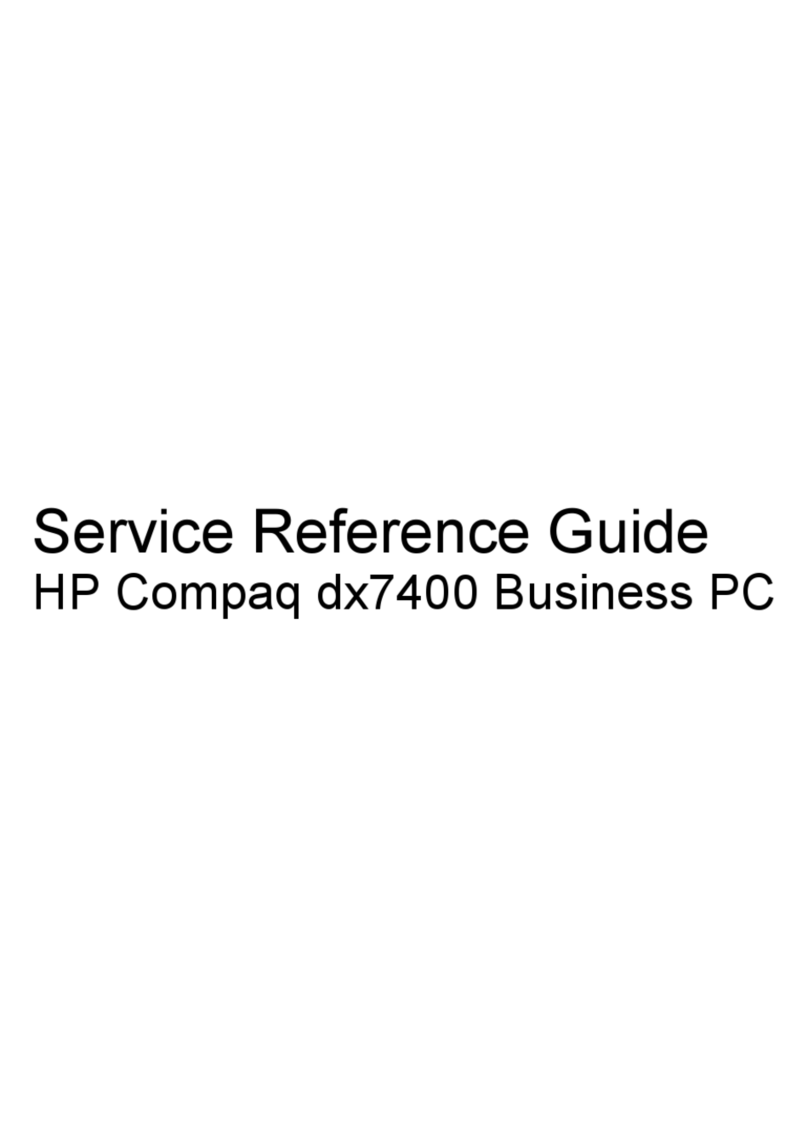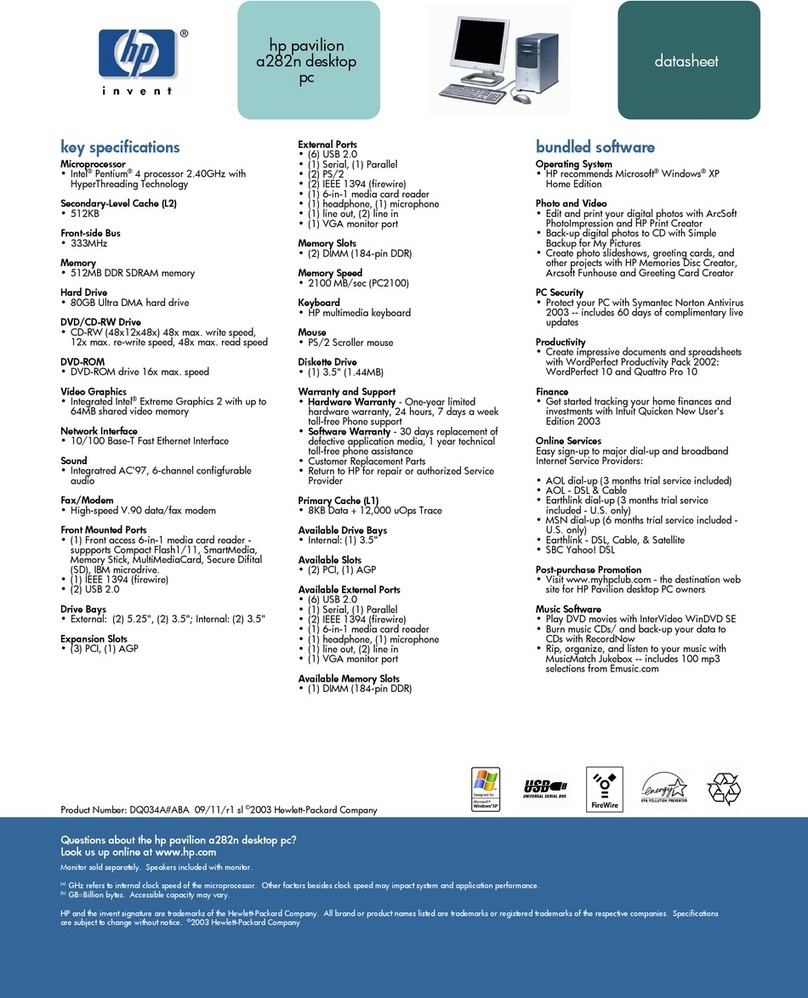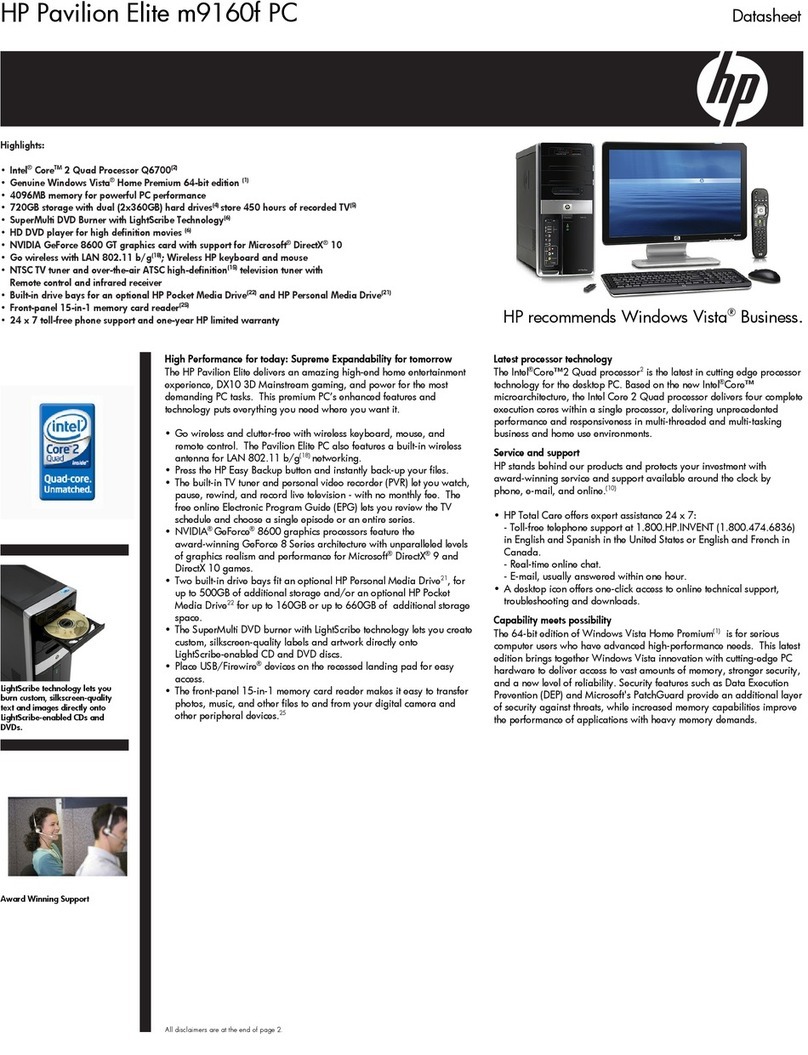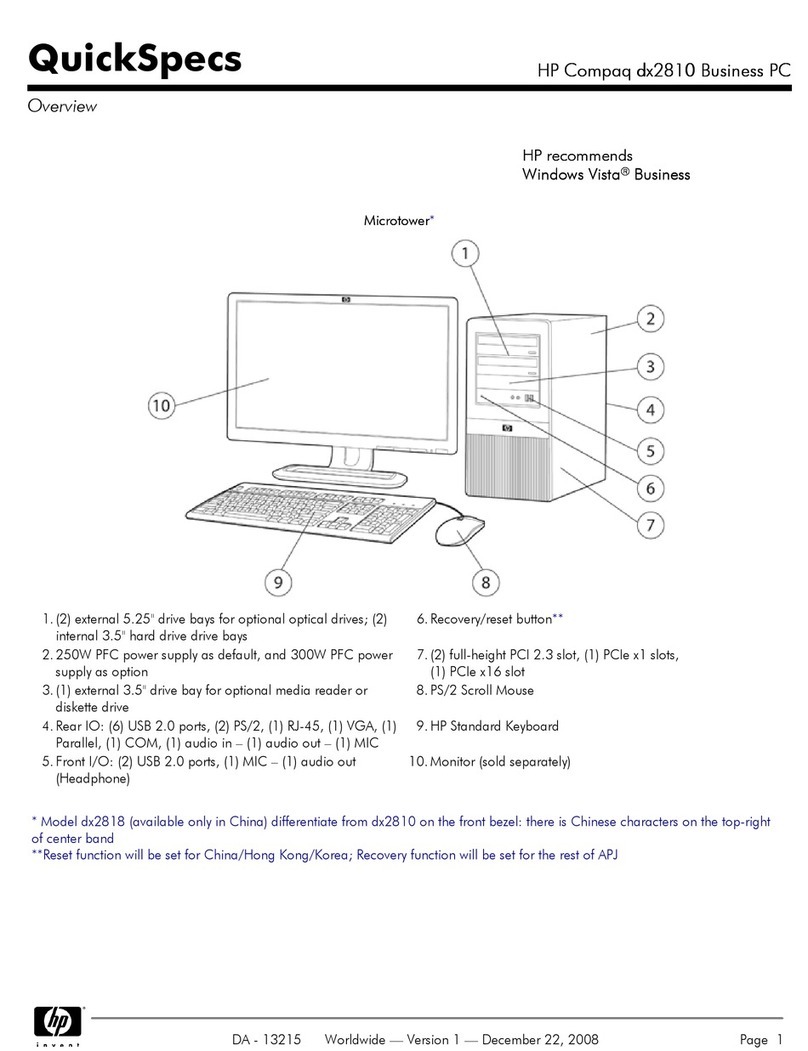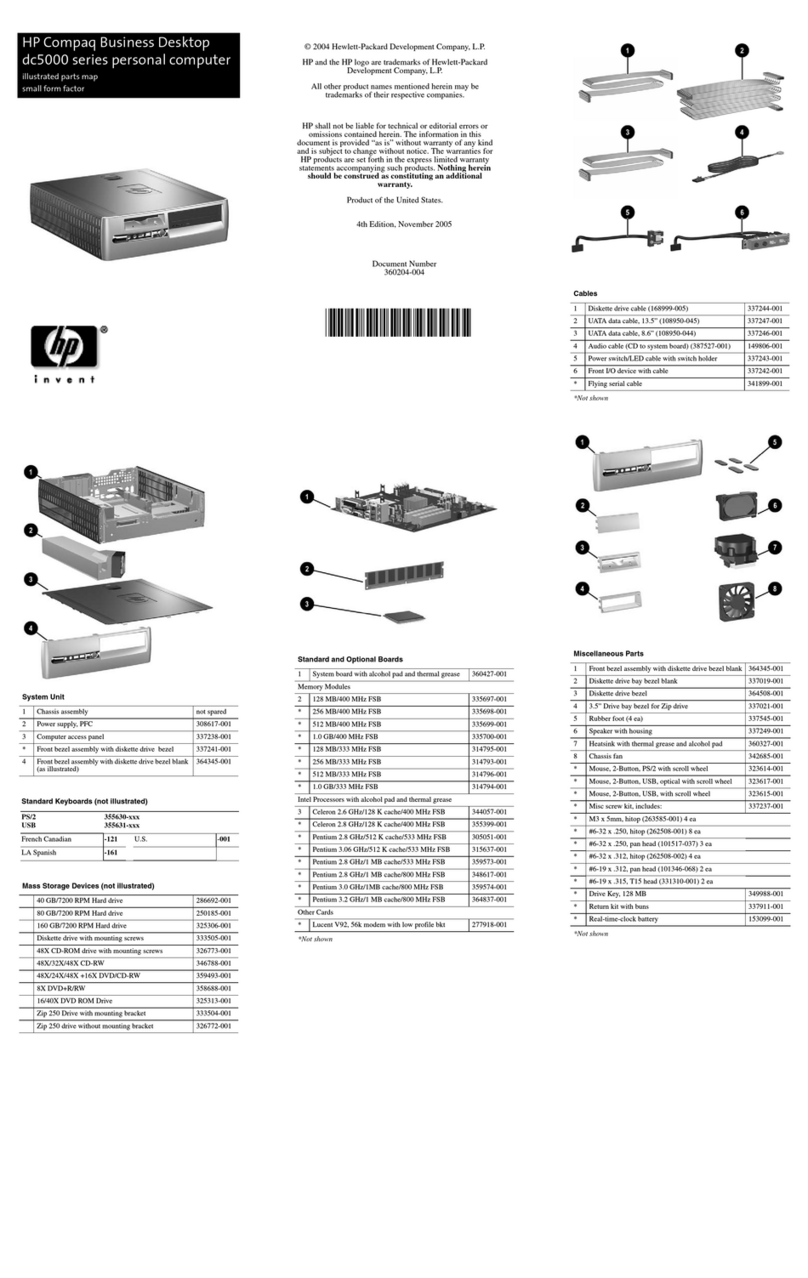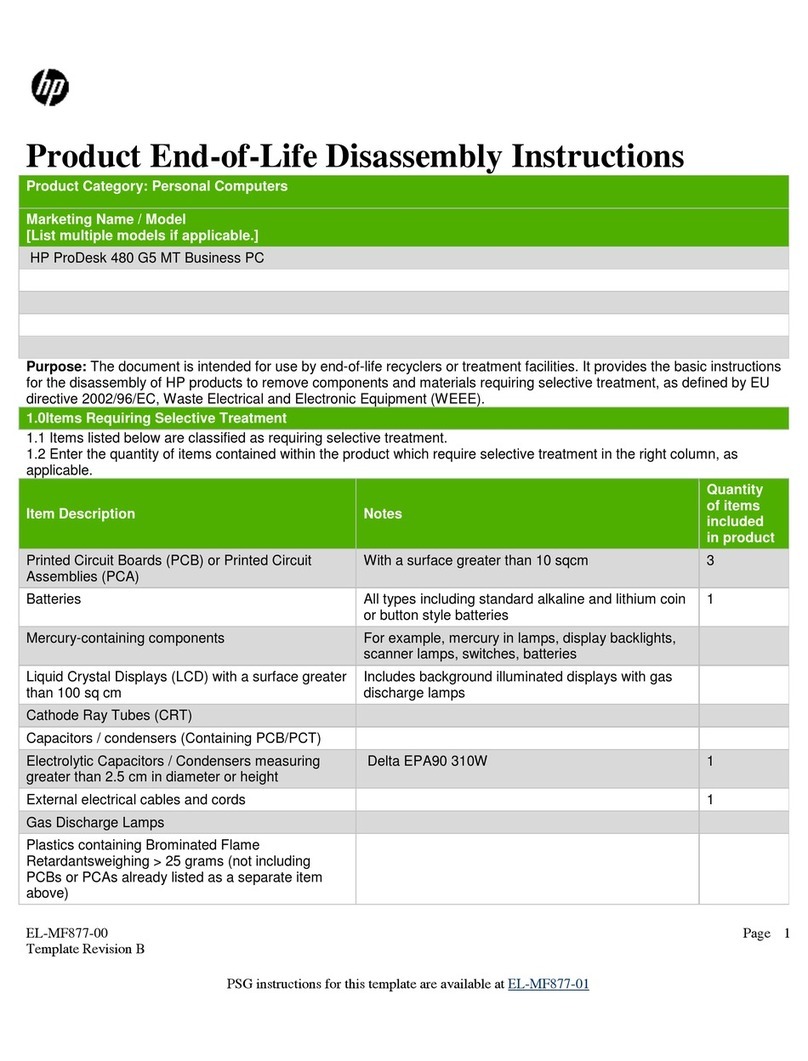
dx2810/dx2818 Illustrated Parts & Service Map, MT chassis 516944-003 page 3
System Setup and Boot
Basic system information regarding system information, setup, power management, hardware,
and passwords is maintained in the Setup Utility held in the system ROM. The Setup Utility is
accessed by pressing the F10 key when prompted (on screen) to do so during the boot sequence.
If the screen prompt opportunity is missed, a restart will be necessary. For more information
about Setup Utilities refer to the Service Reference Guide..
Boot Block Emergency Recovery Mode
Boot Block Emergency Recovery Mode permits system recovery in the unlikely event of a ROM
flash failure. For example, if a power failure were to occur during a BIOS upgrade, the ROM
flash would be incomplete. This would render the system BIOS unusable. The Boot Block is a
flash-protected section of the ROM that contains code that checks for a valid system BIOS
image when the system is turned on.
• If the system BIOS image is valid, the system starts normally.
• If the system BIOS image is not valid, a failsafe Boot Block BIOS provides enough support
to search removable media for BIOS image files. If an appropriate BIOS image file is found,
it is automatically flashed into the ROM.
When an invalid system BIOS image is detected, the system power LED will blink red 8 times,
one blink every second. Simultaneously, the speaker will beep 8 times. If the portion of the
system ROM containing the video option ROM image is not corrupt, Boot Block Emergency
Recovery Mode will be displayed on the screen.
To recover the system after it enters Boot Block Emergency Recovery Mode, complete the
following steps:
Boot Block Recovery
1. Remove any bootable media from the computer and turn off power.
2. Insert a USB flash device or CD containing the BIOS image file in the root directory. The
media must be formatted using the FAT12, FAT16, or FAT32 file system.
3. Turn on power to the system.
4. The system automatically reprograms the ROM.
NOTE: BitLocker prevents Windows Vista from booting when a CD containing the BIOS image
file is in an optical drive. If BitLocker is enabled, remove this CD before attempting to boot to
Windows Vista.
Password Security
The Supervisor password is used to authorize the capability to change BIOS Setup options. The
User password is used to authorize the capability to change non-critical BIOS Setup options
only, such as system date and system time.
• To create a user password, a supervisor password should be activated first.
• If both Supervisor and User passwords are activated and the correct Supervisor password is
entered, all read/write options can be modified.
• If both Supervisor and User passwords are activated and the correct User password is
entered, all options that cannot be modified must be displayed as read-only.
• When a password was not activated, the field displays as “Disabled”.
Establishing a Supervisor password in Computer Setup
1. Turn on or restart the computer. If you are in Windows, click Start > Shut Down > Restart
the Computer.
2. As soon as the computer is turned on, press F10 when the monitor light turns green to enter
Computer Setup. Press Enter to bypass the title screen, if necessary. If you do not press F10
when prompted, a restart will be necessary.
3. Select Advanced, and then select Supervisor Password.
4. Before exiting, click File > Save Changes and Exit.
Changing a Supervisor or User password
If the system is equipped with an embedded security device, refer to the HP ProtectTools Secu-
rity Manager Guide at http://www.hp.com.
1. Turn on or restart the computer. If you are in Windows, click Start > Shut Down > Restart
the Computer.
2. As soon as the computer is turned on, press F10 before the computer boots to the operating
system to enter Computer Setup.
3. Select the Advanced menu, select Change supervisor password or Change user password,
press Enter to modify the password, and then type the new password.
NOTE: Type the new password carefully since the characters do not appear on the screen.
4. Press Enter.
The new password will take effect the next time the computer is restarted.
Disabling a Supervisor or User password
If the system is equipped with an embedded security device, refer to the HP ProtectTools Secu-
rity Manager Guide at http://www.hp.com.
1. Turn on or restart the computer. If you are in Windows, click Start > Shut Down > Restart
the Computer.
2. As soon as the computer is turned on, press F10 when the monitor light turns green to enter
Computer Setup.
3. Select the Advanced menu, select Change supervisor password or Change user password,
and then press Enter twice to disable the password.
4. Press Enter.
HP Insight Diagnostics
Diagnostic functions are provided by the Setup Utility (in system ROM) and by HP Insight
Diagnostics. The HP Insight Diagnostics utility allows you to view information about the hard-
ware configuration of the computer and perform hardware diagnostic tests on the subsystems of
the computer. The utility simplifies the process of effectively identifying, diagnosing, and iso-
lating hardware issues. Insight Diagnostics may be downloaded from the HP Web site using the
following procedure:
1. Go to www.hp.com and click the Software & Download driver link.
2. Enter the product number (for example, dc2810) in the text box and press the Enter key.
3. Select the specific product, and then select the OS.
4. Click the Diagnostics link.
5. Select HP Insight Diagnostics Offline Edition.
6. Click Download.
NOTE: The download includes instructions on how to create a bootable CD.
Red Power LED
flashes eight
times, once every
second, followed
by a two second
pause. Beeps stop
after fifth iteration
but LEDs con-
tinue until prob-
lem is solved.
8 System board fail-
ure or invalid ROM
based on bad check-
sum.
1. Reflash the system ROM with the
latest BIOS image.
2. Replace the system board.
System does not
power on and
LEDs are not
flashing.
None System unable to
power on.
Press and hold the power button for
less than 4 seconds. If the hard drive
LED turns green, the power button is
working correctly. Try the following:
1. Check that the voltage selector
(some models), located on the rear
of the power supply, is set to the
appropriate voltage. Proper voltage
setting depends on your region.
2. Replace the system board.
OR
Press and hold the power button for
less than 4 seconds. If the hard drive
LED does not turn on green then:
1. Check that the unit is plugged into a
working AC outlet.
2. Open hood and check that the power
button harness is properly connected
to the system board.
3. Check that both power supply
cables are properly connected to the
system board.
Computer Setup Menu
Heading Option / Description
Main System Time Allows you to set system time.
System Date Allows you to set system date.
Floppy Diskette A Allows you to set to Disabled, 1.44 MB 3.5”, Not
Installed.
1st Drive
2nd Drive
3rd Drive
4th Drive
Allow you to: view capacity, transfer mode. Also allows
you to run HDD self-test for selected channel: SMART
status check, SMART short self test, SMART extended
self test.
System Information Allows you to view CPU type, CPU speed, cache RAM,
installed memory, memory banks 1-4, BIOS revision,
core version, product name, product number, serial num-
ber, UUID, asset tag (press Enter to change).
Advanced CPU Type View only.
Primary Video
Adapter
Allows you to select boot display device when more
than 2 video options are offered by system: Integrated
(Onboard), PCI, PCI-Ex16.
PS/2 Mouse Disable/enable/auto detect
Internal Speaker Disable/enable.
Supervisor Password Allows you to view the supervisor password.
User Password Allows you to view the user password.
Change Supervisor
Password
Allows you to change the supervisor password.
Power On Password Allows you to disable/enable the Power On Password.
Onboard Video Mem-
ory Size
128MB, 256MB, 512MB
SATA1 Controller Allows you to disabl/enable the SATA1 controller.
SATA1 Controller
Mode
If SATA1 Controller is enabled, allows you to set the
mode to: IDE, RAID, AHCI
Onboard Audio Allows you to set the onboard audio to: Enabled/dis-
abled/auto
Onboard LAN Allows to you disable/enable onboard LAN controller.
Onboard LAN Boot
ROM
Allows you to disable/enable the boot ROM of the
onboard LAN chip.
USB Ports Allows you to disable/enable USB ports.
Hood Sensor Allows you to disable/enable the hood sensoe warning
beep.
IO Device Configura-
tion
Allows you to change the Super IO device resource.
Power After AC Power Fail-
ure
Allows you to select system restart behavior after power
loss: Stay off, Power on, Auto.
XD Disable/enable XD bit.
Virtualization Tech-
nology
Disable/enable.
Boot Boot-time Diagnostic
Screen
Disable/enable POST diagnostic messages display.
F9: Boot Menu Allows you to disable/enable Boot Menu.
F10: Setup Allows you to disable/enable BIOS Setup Menu.
F11: Recovery Allows you to disable/enable HP Backup and Recovery.
F12: Boot from LAN Allows you to disable/enable PXE Boot.
1st Boot Device, 2nd
Boot Device, 3rd
Boot Device, 4th Boot
Device
Allows you to specify which device groups will boot
first, second, third, and fourth or to disable any
of the four: Floppy group, CD-ROM group, Hard drive
group, Network boot group. MS-DOS drive lettering
assignments maybe apply after a non-MS-DOS operat-
ing system has started.
Floppy Group Boot
Priority
Specifies boot device priority within removable devices.
CD-ROM Boot Prior-
ity
Specifies boot device priority within CD/DVD drives.
Hard Drive Boot Pri-
ority
Specifies boot device priority within hard drives.
Network Group Boot
Priority
Specifies boot device priority within bootable network
devices.
Exit Exit Saving Changes Press Enter to exit saving changes.
Exit Discarding
Changes
Press Enter to exit discarding changes.
Load Setup Defaults Press Enter to load setup defaults.
Discard Changes Press Enter to discard changes.
Save Changes Press Enter to save changes.



